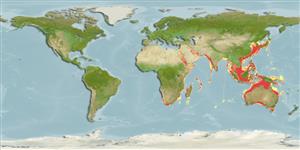Common names from other countries
Environment: milieu / climate zone / depth range / distribution range
Οικολογία
ωκεανόδρομο(ς) (Ref. 75906); εύρος βάθους 0 - 2000 m, usually 1 - 50 m. Tropical; 90°N - 90°S, 15°E - 180°E
Indian Ocean and Western Pacific Ocean.
Length at first maturity / Μέγεθος / Βάρος / Age
Maturity: Lm ?, range 208 - 220 cm Max length : 270 cm BL αρσενικό/απροσδιόριστο; (Ref. 104989); μεγ. δημοσιευμένο βάρος: 230.0 kg (Ref. 104988)
They prefer living on seagrass meadows and rocky substrata (Ref. 114971). Feeds on bony fishes and cephalopods (Ref. 84677). Attacked and preyed upon by tiger sharks Galeocerdo cuvier (Ref. 104930). This species was reported to display complex prey handling of the benthic-dwelling Maori octopus (Macroctopus maorum), processing its prey by shaking and tossing (Ref. 122728). The same octopus was reported to have asphyxiated an adult male of this species, with the octopus arms protruding from the mouth and the rest of the body blocking the pharynx, larynx and
esophagus (Ref. 122729). Occurs in pods of various numbers (Ref. 129713).
Rice, D.W. 1998. (Ref. 1522)
IUCN Red List Status (Ref. 130435)
CITES status (Ref. 108899)
Human uses
αλιεία: Εμπορικό(ά); δόλωμα: usually
FAO - αλιεία: landings | FishSource | Η θάλασσα γύρω μας
Εργαλεία
Περισσότερες πληροφορίες
Age/SizeΑύξησηLength-weightLength-lengthΜορφολογίαΠρονύμφεςΑφθονία
Διαδικτυακές πηγές
Estimates based on models
Preferred temperature
(Ref.
115969): 21.9 - 29, mean 27.6 (based on 2288 cells).
Price category
Unknown.
